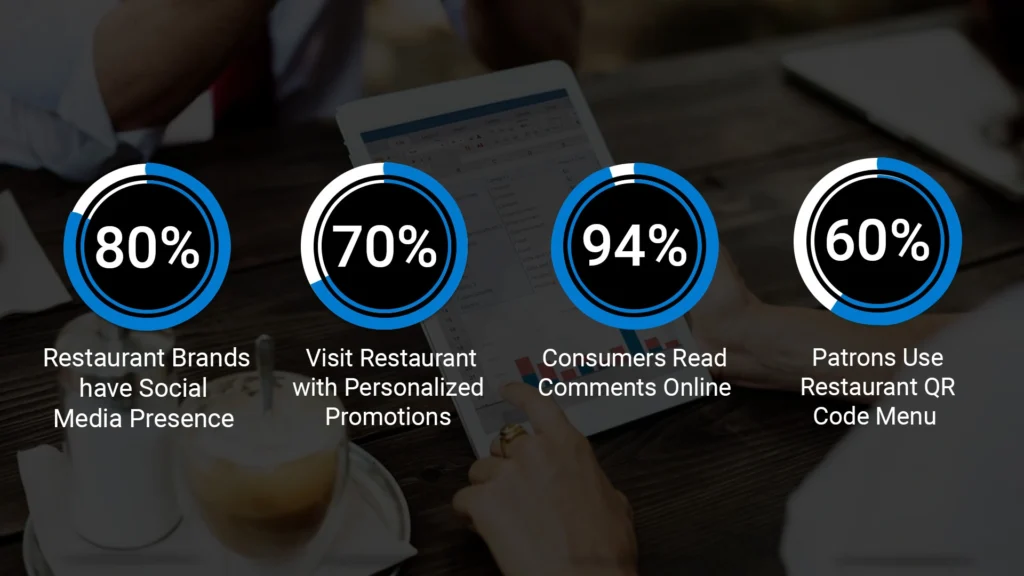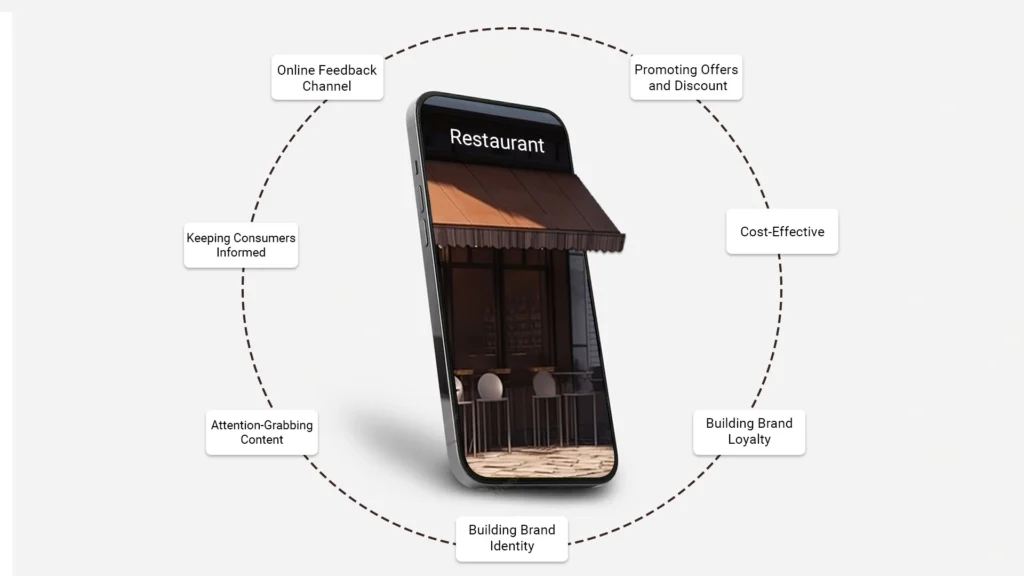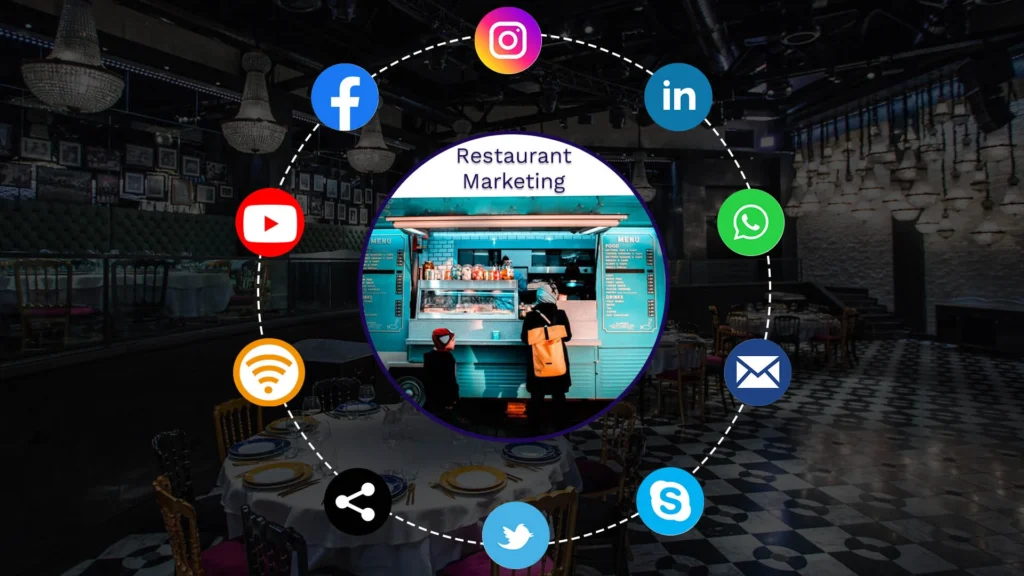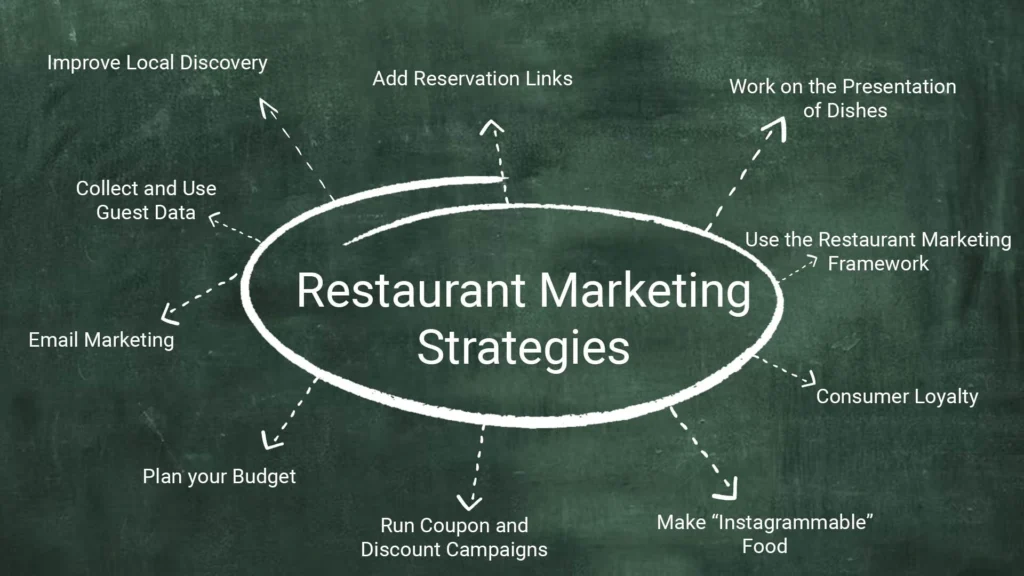In today’s competitive market, restaurateurs must implement effective marketing strategies to attract and retain customers. You need effective restaurant marketing strategies to help you grow your business and increase your bottom line.
First, it’s important to understand your target audience and what they’re looking for in a restaurant experience. Are they looking for a fine dining experience or a cozy atmosphere? Are they interested in local or exotic cuisines?
By understanding your customer’s needs and preferences, you can tailor your marketing efforts to attract them and build customer loyalty.
Another important aspect of restaurant marketing is establishing a strong online presence. Customers often turn to the internet to research restaurants and make reservations in today’s digital age. That’s why having a well-designed website that’s easy to navigate and showcases your menu, specials, and other important information is important. Additionally, having a presence on social media platforms like Facebook and Instagram can help you connect with customers, showcase your food and beverages, and promote your business.
In this blog, we will also discuss the importance of customer service and the role it plays in restaurant marketing. Providing excellent service and creating a welcoming atmosphere can go a long way in building a strong reputation for your business and encouraging customers to return.
Finally, we’ll discuss some creative marketing strategies to help your restaurant stand out. From hosting events and promotions to partnering with other local businesses, there are plenty of ways to promote your restaurant and attract new customers.
What is a Restaurant Marketing Strategy?
A restaurant marketing strategy is a plan of action to promote a restaurant’s products and services, attract customers, and increase sales. This involves identifying target customers, defining unique selling points, setting marketing objectives, and using various marketing channels such as social media, email marketing, advertising, promotions, and events. to captivate customers. Moreover, a successful restaurant marketing strategy should help build brand awareness, generate leads, and build customer loyalty.
The main marketing goals for restaurants are attracting new customers, retaining existing ones, and increasing sales and profitability.
Why is a Restaurant Marketing Strategy Important?
A comprehensive marketing campaign is instrumental in helping restaurants expand their reach and establish a strong reputation among consumers. After all, customers cannot visit a restaurant they are unaware of. Through effective advertising, restaurants can increase their brand awareness, ensuring that their name becomes recognized by consumers. This increased visibility plays a crucial role in attracting new customers and building a strong reputation in the industry.

A restaurant marketing strategy is important for several reasons:
1. Attracting Customers: A well-planned restaurant marketing strategy helps a restaurant reach its target audience and attract new customers.
2. Brand Awareness: An effective marketing strategy creates brand awareness and recognition, which are critical to long-term success.
3. Competitive Advantage: In a crowded market, restaurant marketing strategies can provide a competitive advantage over other businesses.
4. Increased Revenue: A successful marketing strategy can increase sales and revenue, helping a restaurant grow.
5. Customer Loyalty: By implementing marketing strategies that build strong relationships with customers, restaurants can increase customer loyalty and retain customers.
Importance of Digital Marketing in Restaurants Success
Digital marketing plays a vital role in the success of restaurants, offering various benefits such as expanding your customer base, optimizing cost-efficiency, and fostering direct customer engagement. Below, we have highlighted key reasons digital marketing is indispensable in the restaurant industry.

Building Brand Identity
Digital marketing is a powerful tool for building and solidifying your restaurant’s brand identity. When running a restaurant, it’s crucial to recognize the process of establishing your brand. A restaurant’s brand serves as a means of conveying its unique story and can provide valuable insights into the quality of its food and overall experience. By implementing an effective digital marketing strategy, you can maintain and enhance your brand’s reputation, identity, and reliability, ultimately attracting and engaging new customers.
Cost-effective
Online marketing for restaurants offers a cost-effective alternative to traditional marketing methods. With a vast audience and the potential for substantial revenue, digital marketing provides a low-cost solution for reaching and engaging customers. Compared to traditional marketing, digital campaigns are more efficient in increasing restaurant visibility. The expenses associated with digital marketing are minimal, and platforms like Facebook and Instagram offer affordable options for running advertisements. Moreover, digital marketing proves to be more cost-effective per lead when compared to traditional approaches.
Online Feedback Channels
When it comes to attracting new diners, reviews and feedback from other individuals hold more weight than what restaurants say about themselves. Online reviews play a crucial role in informing potential customers about the opinions and experiences of current patrons, making them highly valuable for a restaurant’s success. These reviews significantly impact potential clients searching for online feedback, influencing their decision-making process.
Building Brand Loyalty
Social networking is a valuable tool for businesses to connect with customers, building trust and loyalty. Through digital marketing, especially on social media, restaurants can engage with customers, receive feedback, and create a personal touch that increases brand awareness and fosters loyalty. This connection helps customers feel more invested in the brand.
Promoting Offers and Discounts
Social media provides an excellent platform for promoting and maximizing the benefits of deals and promotions. Digital marketing offers a straightforward approach to showcasing various offers and attracting new customers. You can achieve better results from ongoing special offers and promotions by utilizing practical restaurant digital marketing tools. Offering discounts and coupons to customers encourages engagement, resulting in more likes and shares. This proves to be a highly effective method for rapidly promoting your brand and attracting both repeat and new customers.
Keeping Consumers Informed
Keeping up-to-date information is crucial in the digital age, and restaurants can leverage digital marketing to provide customers with the necessary and accurate information. This includes sharing details such as location, opening hours, menu, and contact information through websites, business listings, and social media platforms. Websites can be valuable for customers to explore and learn more about the restaurant’s background. Additionally, when used effectively to share regular, relevant, and engaging content like blogs, a website becomes a vital asset in a restaurant’s digital marketing strategy.
Attention-Grabbing Content
Visual appeal matters when it comes to food. Incorporating captivating images and engaging content into a digital marketing strategy can significantly benefit restaurants. Social media platforms offer an ideal avenue for sharing mouthwatering pictures, behind-the-scenes glimpses, and exclusive menu items. By consistently posting fresh and enticing content, restaurants can attract new visitors and entice repeat customers to return for more.
Restaurant Marketing Guide
Marketing is an essential part restaurant’s growth. This helps attract new customers, retain existing customers, and build a positive brand image.

Here’s a restaurant marketing framework to help you market your restaurant and increase your sales:
- Create a Unique Brand Identity
- Create a user-friendly website
- Using Social Media
- Invest in local SEO
- Offers online ordering and delivery services
- Launch a promotion
- Organize events
- Partner with Influencers
- Collect customer feedback
- Watch your online reputation
How to Market a Restaurant
Marketing a restaurant involves various strategies and tactics to attract and retain customers with various restaurant photography tips. Here are some restaurant marketing ideas and trends to market your restaurant effectively:
- Determine your target audience: You need to know your ideal customers before marketing your restaurant. Create targeted marketing plans that consider factors such as age, gender, income, location, and dining preferences.
- Build a strong online presence: Have a website and social media to expand your audience. Make your website mobile-friendly, including key info like menus, hours, location, and contact details. Share food photos, engage with followers, and boost visibility with hashtags.
- Encourage online reviews: Positive reviews on sites like Yelp, Google My Business, and TripAdvisor help build trust with potential customers. Encourage happy customers to leave reviews by offering incentives such as discounts or free desserts.
- Offer promotions and specials: Discounts, happy hour specials, and limited-time menu items can create a sense of urgency and encourage customers to visit your restaurant.
- Hosting events: Hosting events like live music, quiz nights, or themed dinners can attract new customers and retain regulars.
- Partner with local businesses: Partner with nearby businesses such as hotels, theaters, and tourist attractions to offer discounts or special packages to their customers.
- Invest in visual merchandising: Share stunning food photos and videos on social media and your website to attract customers. Hire a professional food photographer for captivating visuals of your restaurant and menu.
- Prioritize customer service: Providing excellent customer service can lead to repeat customers and positive word-of-mouth referrals. Train your staff to be friendly, attentive, and knowledgeable about your menu.
Restaurant marketing requires professional food photography for a multifaceted approach that combines online and offline strategies. To make perfect portfolio images of your restaurant, you must contact Spyne.
Low-Budget Restaurant Marketing Ideas
Many restaurants prefer low-budget restaurant marketing because of affordability, flexibility, and authenticity.
Here are some low-budget restaurant marketing Ideas:
- Offer specials
- Organize an event
- Loyalty Programs
- Offer discounts or free items for every X visit or purchase.
- Social Media
- Email Marketing
- Collaborate with other businesses
- Catering
- Online ordering
- Promote Happy Hour
- Local Advertising
Restaurant Marketing Tips
Here are some restaurant marketing tips that can help you attract and retain customers:
- Know your target audience: Find out who your target audience is and what they like. Use this information to create a menu and atmosphere that appeals to them.
- Online Presence: Create a website and social media accounts for your restaurant. Share high-quality photos of your dishes, create engaging content, and encourage customers to leave reviews.
- Events and promotions: organization of events and promotions to attract new customers. For example, offering a special menu for parties or organizing a charity event.
- Cooperation with local businesses: Cooperate with local businesses and promote each other. For example, offer discounts to guests at nearby hotels or tourist attractions.
- Online ordering and delivery: Offer online ordering and delivery services to make it easier for customers to order from your restaurant. Works with popular delivery services like Grubhub, Uber Eats, and DoorDash.
- Email Marketing: Collecting customer email addresses and using them to send newsletters and special offers.
- Community Involvement: Get involved in the local community by sponsoring events or participating in local charities. This helps establish a good reputation for your restaurant.
- Upsell: Train your staff to upsell customers additional items or upgrades. For example, suggest offering desserts or drink specials with meals.
- Responding to Feedback: Respond to positive and negative feedback professionally and respectfully. It shows that you care about your customers’ experience and are willing to change based on their feedback.
Top Restaurant Marketing Strategies
Here are some marketing strategies for the food business to help you promote your restaurant and attract more customers to your restaurant:

Add Reservation Links to Google Business
Adding a reservations link to your Google Business Profile can have a major impact on your restaurant marketing for several reasons:
1. Increased Visibility: Customers can easily book a table and search for restaurants directly from the search engine results page. This can increase your visibility and attract more customers to your business.
2. Convenience: Many customers prefer the convenience of reserving a table online rather than calling or visiting in person. By providing a reservation link, you can make it easier for customers to reserve a table at your restaurant, which leads to more reservations and increased revenue.
3. Improve customer experience: By providing a booking link, you can simplify the booking process for your customers, making it more efficient and user-friendly. This can lead to a better overall customer experience, which results in positive reviews, repeat business, and word-of-mouth referrals.
4. Analytics and Insights: When you use a booking system integrated with your Google Business Profile, you can track data and information about your customers’ booking behavior. It can help you make informed decisions about marketing strategy, menu offerings, and customer service.
Work on the Presentation of Dishes So They Are “Instagrammable”
The presentation of dishes is important to make them “easy to download” or visually appealing to share on social media platforms like Instagram. Here is some marketing strategy for a food business that can help make a dish more visually appealing:
1. Colorful garnishes: Incorporating a variety of colorful garnishes into a dish can make a dish more visually appealing and interesting. Using a contrasting color can make dishes pop and stand out in the flow.
2. Plating: How a dish is placed on a plate or bowl greatly impacts its visual appeal. Plating techniques such as stacking, layering, or arranging ingredients in patterns can make a dish look more professional and appealing.
3. Garnishes: Adding toppings like herbs, micro greens, or edible flowers can add texture and depth to a dish. They can also make it more visually appealing by adding a splash of color or creating an interesting contrast using food photo editors.
4. Props: Adding props such as unique dishes, tablecloths, or bowls can add an interesting element to a photo and make it more visually appealing.
5. Lighting: Good lighting is essential for great food photos. Natural light is usually best, but artificial lighting can also be used to accentuate certain areas of the dish.
Improve Local Discovery Online Via SEO
Improving local online discovery through search engine optimization (SEO) can be a powerful tool in restaurant marketing. Here are some ways SEO can help a restaurant grow its online presence and attract more customers:
1. Increase Visibility: Optimizing a restaurant’s website and other online presences for Local search can help it rank higher in search engine results pages (SERPs).
2. Targeted Traffic: SEO can help target a specific audience looking for a specific type of cuisine or dining experience.
3. Improve user experience: This can include improving site speed, mobile friendliness, and usability.
4. Reputation Management: This includes things like addresses, hours of operation, menu items, and customer reviews. This readily available information helps build trust with potential customers and improves your restaurant’s reputation.
5. Profitable Marketing: SEO is a profitable form of marketing that can provide long-term benefits. Unlike paid advertising, which is expensive and requires ongoing investment.
Use the Restaurant Marketing Framework
You can follow this basic restaurant marketing framework:
- Define your target audience
- Develop your value proposition
- Build your brand
- Developing a Marketing Plan
- Execute your marketing plan
- Measure your results
- Refine your strategy
Overall, the Restaurant Marketing Framework provides a structured approach to restaurant marketing that can help you effectively reach your target audience, build your brand, and drive sales.
Email Marketing That Actually Works
Sending effective marketing emails can have a major impact on restaurant marketing by:
- Increase Customer Engagement
- Brand Loyalty
- Generating Sales.
- Customer Feedback
Focus on Consumer Loyalty
Consumer loyalty can significantly impact restaurant marketing by influencing customer behavior and driving repeat business. Here are some ways that consumer loyalty affects restaurant marketing:
- Repeat Business
- Word of Mouth Marketing
- Social Media Presence
- Brand Reputation
Collect and Use Guest Data
Collecting and using customer data is a marketing strategy many restaurants follow because it can help restaurants better understand customers, refine marketing efforts, and ultimately drive more business. Here are some steps for restaurants to collect and use customer data in their marketing campaigns:
1. Data Collection: This can be done through various methods such as opt-in emails, loyalty programs, surveys, and social media interactions.
2. Data Analysis: This involves looking at purchase history, survey responses, social media interactions, and other data points to identify patterns and trends.
3. Customer Segmentation: Through data analytics, restaurants can segment customers into different groups based on behavior, preferences, demographics, and other factors. This allows restaurants to tailor marketing campaigns to specific groups.
4. Personalization of Marketing Efforts: Restaurants can personalize marketing efforts to individual customers. This may involve sending targeted emails with personalized recommendations or using customer data to create targeted social media advertisements.
5. Improve customer experience: Finally, customer data can be used to improve the overall customer experience by identifying areas where customers may be dissatisfied or where restaurants can improve. By listening to customer feedback and making changes based on data analysis, restaurants can create a more enjoyable dining experience that keeps customers coming back.
Ways To Make “Instagrammable” Food
“Instagrammable” food is becoming increasingly important in the world of social media and restaurant marketing.
Here are some ways restaurants can make their food more Instagram-friendly:
1. Introduction: When it comes to Instagram-friendly food, the introduction is key. Restaurants can make dishes more visually appealing by using bright colors, varying textures, and unique presentation techniques.
2. Lighting: Good lighting is essential for great food photos. Lighting can make food more appetizing and help accentuate certain dish characteristics.
3. Uniqueness: Unique and unusual foods often suit Instagram best. Restaurants can create special, visually striking dishes or unusual flavor combinations. This creates a buzz on social networks and attracts new customers.
4. Branding: Incorporating branded elements into feeds can make them more Instagram-worthy. This may involve adding the restaurant’s logo or name to dishes or using branded crockery or cutlery.
5. Posts to share: Dishes to share or articles designed to be shared on social networks are also very effective. This could involve making dishes big or tall or adding interactive elements to dishes to encourage customers to take photos and share them on social media.
Run Coupon and Discount Campaigns
Running coupons and discounts is a common restaurant marketing strategy to attract new customers and increase sales. Here are some steps of a restaurant marketing campaign:
1. Identify Campaign Objectives: This involves setting goals for the number of new customers attracted or the amount of revenue generated during the event.
2. Determining the quote: The next step is to determine the specific quote that will be offered to the customer. These may include percentage discounts, amount discounts, free items with purchase, or buy-one-get-one-free promotions.
3. Decide on the duration: It is important to decide on the duration of your coupon or discount campaign. This may involve setting specific start and end dates or using limited-time offers to create a sense of urgency.
4. Publicizing an offer: Once it has been identified, it is important to advertise it effectively using social media, email marketing, or targeted advertising to reach potential customers.
5. Tracking results: Finally, it is important to track the results of a campaign to determine its success. This may involve tracking the number of redemptions, revenue generated, and new customers acquired during the event.
How Much Should I Spend on Restaurant Marketing?
Your restaurant marketing budget depends on several factors, such as restaurant size and type, marketing goals, and budget. However, as a general rule, restaurants should allocate around 2-3% of their total sales to marketing.
For example, if your restaurant has gross sales of $500,000 annually, you should allocate $10,000 to $15,000 annually for marketing.
However, this percentage may vary depending on your objectives and priorities. If you’re opening a new restaurant or launching a major marketing campaign, you may need to allocate a higher percentage of your budget to marketing.
It is important to remember that marketing is an investment in the future success of your business. Although it may initially seem costly, a well-executed marketing campaign can increase awareness, attract new customers, and drive revenue growth.
Conclusion
Any restaurant business’s success relies on an effective marketing strategy; therefore, it is essential. By understanding your target audience, developing a strong brand identity, utilizing social media platforms, offering discounts and promotions, and providing excellent customer service, you can increase your restaurant’s visibility and attract more customers.
Additionally, prioritizing online ordering and delivery options is crucial as customers increasingly prefer to order food from the comfort of their own homes. By implementing these marketing strategies, and food photography ideas, and constantly evaluating and adjusting your approach, you can ensure the long-term success of your restaurant business.
















